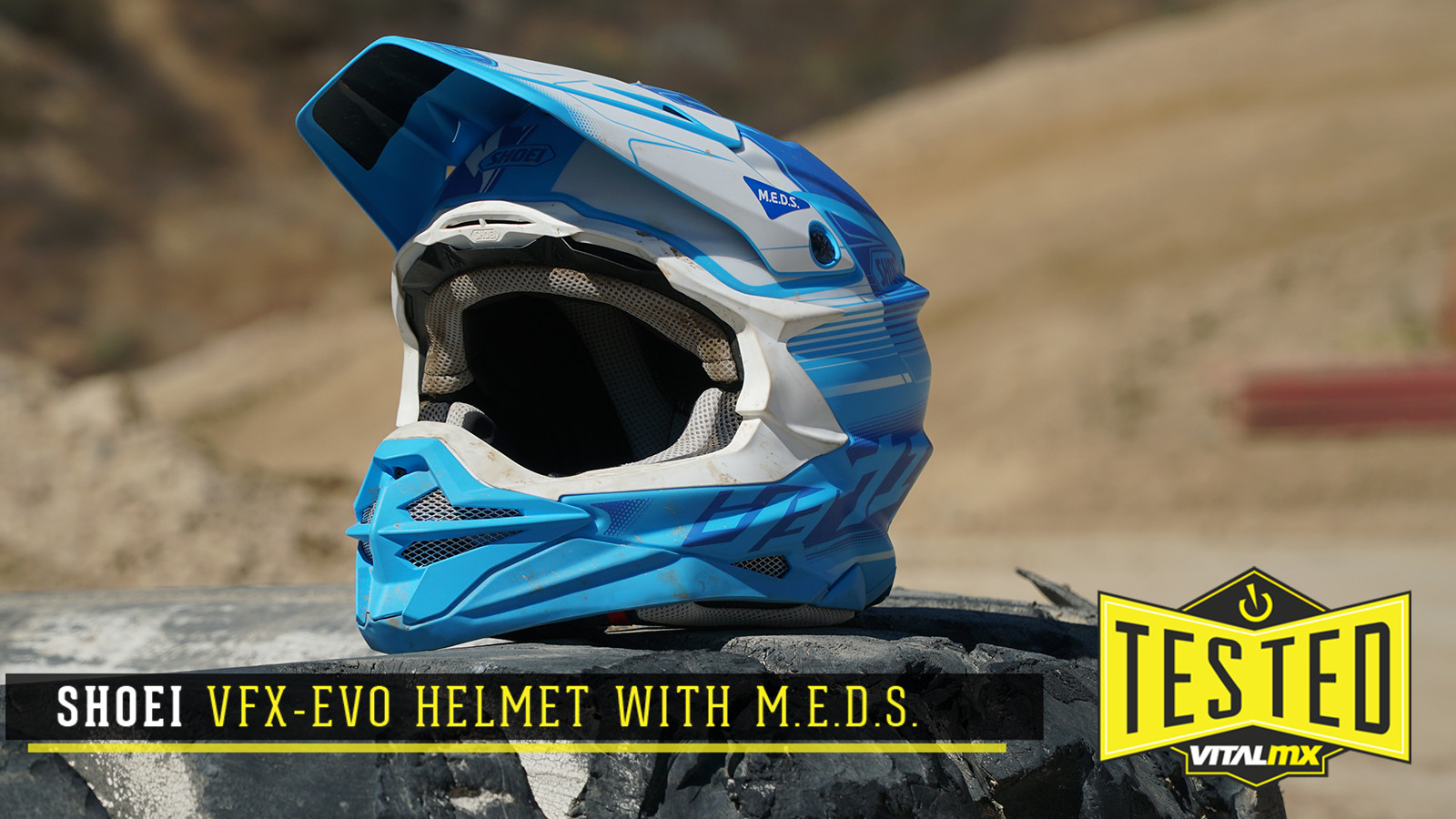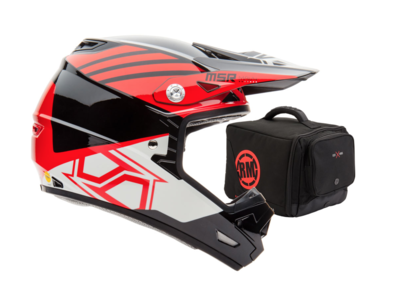Shoei VFX-EVO Helmet

Out of the hundreds of off-road helmets on the market, there are only a few brands that rise to the top of the list. Shoei is one of those brands and in modern motocross and off-road racing, the VFX-W helmet has been their only off-road model. Now, the VFX-W has been replaced with the VFX-EVO - not just an updated name and look, but an updated protection technology as well.
Shoei VFX-EVO Features:
- Fully loaded with next-level performance, safety, style and progression
- Proudly boasts the SHOEI-exclusive Motion Energy Distribution System [M.E.D.S.]
- All-new V-470 visor provides a seamless connection with the shell, optimal roost protection, and secure positioning
- Optimally-designed vents, an aerodynamic shell, and cooling EPS channels yield superior airflow
- SHOEI’s strongest, lightest, most elastic shell provides optimal impact absorption
- Max-Dry liner material absorbs and dissipates sweat 2X faster than traditional nylon interiors
First Impressions
Helmet graphics are really a personal choice, and while I didn’t choose this graphic myself (chosen for me by ML for the 450 Shootout), I don’t get super picky when it comes to matching my helmet to my gear. Also, the matte finish on a few of the colorways is pretty cool, but takes a little getting used to. It just feels different - like it is slightly rubbery to the touch.
Also, the main defining feature of the VFX-EVO is its M.E.D.S. technology. Michael does a good job of explaining the Motion Energy Distribution System in this video. The short version is that there is a separate EPS layer in the top center of the helmet that is anchored by a center column with three other columns that absorb rotational energy when an impact occurs. This EPS “cup” can rotate and swing in any direction and the best part is, it is completely imperceptible when riding in the helmet.

On The Track
As we all know, fit is the most important factor in choosing a helmet. If it doesn’t fit right, it isn’t going to work right. As you may have seen in this Shoei Helmet Fitting Video, I originally ordered a Large since that is what I wear in most helmet brands. But, according to Shoei I’m better off in a Medium size helmet. But I also asked for the 31mm cheek pads to replace the 35mm that come stock in the helmet. This is something that anyone buying a Shoei can do, free of charge. Overall, Shoei claims their helmet to be an intermediate oval shaped helmet meaning is is a little longer front to back, which is a typical American/European head shape. I have a more round, but tall, head and the medium fits me very well, with the skinner cheek pads to fit my large face.

At first, even with the thinner cheek pads, I still noticed some discomfort around my temple and jaw area after spending a whole day at the track. But, after about the third ride, this went away. My guess is that the padding had to break in a little bit, or my head just got used to it. Ventilation is good, but not as good as I would hope for a premier helmet. Having just worn the new Alpinestars helmet, the ventilation in that lid is really impressive, and maybe tainting my view of the VFX-EVO. Even on the hottest of days, I’d still wear the Shoei without issue, it just doesn’t feel like a wind tunnel is on the top of my head.
The liner material is very comfortable, allowing me to have any kind of stubble or beard I want. Some pads grip facial hair and want to rip your skin off, but this material is smooth and soft. The ear openings are a touch on the small side to where I would have to wiggle the helmet around to get my ears aligned just right, but then again, I have pretty big radar dishes on my head. I sweat more than anyone I know, and the padding did a great job of keeping it out of my face while riding. During the 450 Shootout, I did have drops of sweat coming out of the helmet towards the end of the day, but I don’t think any helmet could help that. Plus, I went quite a few rides before washing the liner and I have to say this is probably the non-smelliest helmet I’ve ever worn.

Speaking of washing, I’ve thrown the cheek pads and crown liner in the washing machine a few times and everything looks great. They even went through the drier (gasp!) when my wife didn’t know they were in the laundry without any detriment that I can tell. Liner removal and installation is straight forward but a little more complicated than it needs to be. I like a helmet with just three snaps on each cheek and four snaps for the crown. The VFX-EVO, on both the cheek and crown, has plastic tabs that slide into the edge of the helmet that is sort of a dated design, but I’m just being picky.
I like that the mouthguard is removable/replaceable, not that I foresee the need for that, but it’s a good option. The visor is adjustable with shear-off plastic bolts and with the visor adjusted to its upper limit, it is in the perfect spot. It also mates with the shell to make it more aero, at least that’s what Shoei claims. The VFX-EVO doesn’t feel like the lightest helmet on the market, but it it also doesn’t feel like the heaviest either. It came in at - 1,628 grams on our office mail scale, which is 3.5 pounds, a little heavier than what other reviews claim so our scale might not be super accurate.

There are a few cons to the Shoei, at least in the matte finish. I find it harder to get clean, like it holds on to dirt more. With glossy helmets, it’s easy to pick-off dirt clumps and then buff it with your fingers real quick. But the matte makes that harder. Plus, even with water and a rag, the dirt left a little bit of color. I’ve hit it with some Simple Green and that does the trick.
Also, the goggle channel is overkill. While it is nice to have a clear and obvious physical channel to put your goggle strap into, the curvature in the channel doesn’t let the goggle strap plastic adjusters to lay flush on the helmet. I’m totally splitting hairs here, but it is just a little confusing why that area wouldn’t be more flat.

Last Words
This has been my go-to helmet for months. Sure, I’m wearing it for this test but I’ve also worn some helmets that I just dreaded putting on my head. The VFX-EVO isn’t one of those. While they weren’t the first in the rotational energy management game, I do feel extra peace of mind with the M.E.D.S. technology in this helmet. With the cheek pads swapped out, this is one of the best fitting helmets for my head and face. Ventilation is on the better side of good and the liner material doesn’t leave my cheeks red and raw. Overall, the VFX-EVO is a solid, top-shelf motocross helmet option.
For more helmet reviews check out our Product Guide and leave a review of your own helmet.





















































0 comments
Post a reply to: Tested: Shoei VFX-EVO Helmet